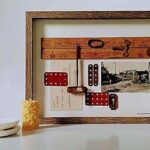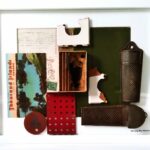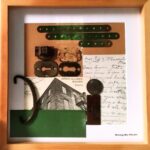Dale’s Antiques

Dale’s is a large and eclectic store located on Highway 21 near The Pinery Provincial Park. We often stopped there on our way to the park, or to the Lambton Heritage Museum nearby. As well as custom-made Mennonite furniture, Dale’s has an extensive selection of Canadian and American antiques. After I bought about ten small objects there to use in my memory boxes, the owner, Todd, showed an interest in what I was doing with them. He looked at photographs of my work, and soon after I was dropping off eight finished pieces to display at his store. I hope you will enjoy the following background information on the works now on sale at Dale’s.
Tin Ceiling Triangles
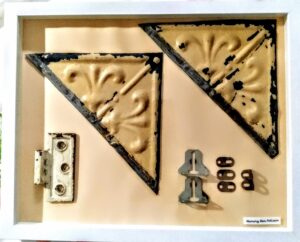
The work “Tin Ceiling Triangles” contains pieces of tin that builders used on ceilings throughout buildings in Ontario, and in other parts of North America. Tin was an inexpensive alternative to elaborate plaster ceilings, which were very labour intensive and required specialized skills. These ceilings were beyond the financial means of most people, but the mass produced, patterned tin pieces were easily installed by retailers and homeowners. Now we see the beauty in any patterned ceiling since plain ceilings are the norm. I have arranged the tin pieces to highlight the other mid-1800’s design elements from our area in the box.
Many Boxes
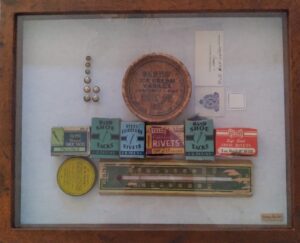
“Many Boxes” was inspired by small boxes of shoe tacks that came from Todd’s store. The boxes have deep rich colours, unusual shapes, typefaces that recall the past and which arouse a feeling of nostalgia. These small boxes were an integral part of daily life: this early advertising on the outside of containers was both creative and attractive. Now that the boxes have aged, and the cardboard has mellowed in colour and texture, I find them interesting building blocks for memory boxes.
Metal Pieces
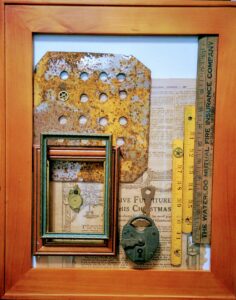
“Metal Pieces” has an incredibly unique background! My sister Susan found the large rusty piece on the road near her house in Casselman. She sent it to me by mail, and I happened to have a picture frame that was almost identical in colour to the rusty hue. It seemed very intuitive to put the two items together, and the match is quite arresting. I found other items that complement the distinctive hue that pull together a narrative of erosion and tarnishing, and the beauty in the colour of decomposition. I also used small frames within frames to highlight the rectangle shapes and the wood.
St Jacob’s Bridge, Thousand Islands, Toronto Artist’s Alliance
“St. Jacob’s Bridge,” “Thousand Islands,” and “Toronto Artist’s Alliance” are all titles I chose for three more memory boxes hung at Dale’s. Each memory box contains a postcard of that same place in Ontario. The postcards are handsome depictions of sites from the era 1910-1914. I realized they would make a good central feature of a memory box, because of the photography on the front side and the old stamps and handwriting on the back. Postcards have now almost disappeared from use, and I see them as an art form. Postcard collecting is popular because of unusual photography, colour tinting or views of places that have long disappeared or radically changed. I like the simplicity of the cards, which were a fast way to send a message, before the advent of the phone camera and texting.
The three memory boxes just described have other content in common. I discovered a box of old Meccano pieces at the Pinery Market this summer. Meccano was originally a British toy manufacturer who made pieces for kids to construct models of bridges and machinery. I was attracted to the pieces’ uniformity and colours: some deep greens and reds as well as gold circular parts. The Meccano parts evoke handmade toys and an era of teaching-type toys. They look used and there could be a story behind well-spent hours of play.
